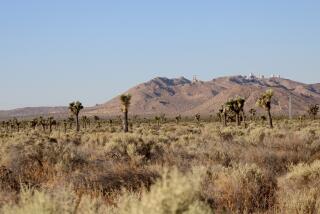Mojave Desert
- Share via
Although Charles F. Lummis was not my grandfather or great uncle, his walk across the Mojave Desert is known to me (letter, May 17). My father, Belcher Cooley, was a surveyor, a member of the team that mapped the route for the third “emergency” power line between Hoover (then Boulder) Dam and Los Angeles. The line ran across the Mojave to Victorville, then north of the San Gabriel Mountains to Los Angeles. Following a route distant from the other two lines, the third line was intended to serve the city’s electrical power needs in case an earthquake or other disaster damaged those lines.
Of course the people who live and work in the desert should be heard on the subject of the establishment of a national park in the Mojave. Few public works survive in this, our federal democratic republic, without such hearings. It is probably fortunate that such magnificent national treasures as Yosemite, Yellowstone, and Sequoia National Parks were established in earlier times; who knows if they would have survived such a process.
It should be remembered that many more interests are involved; a national park has enormous long-term benefits for the local community and for the nation. The Bureau of Land Management plan for the desert may be adequate, or it may not; in any case its execution and enforcement are not. Historic sites and intaglios have been defaced by careless unrestricted travel.
Desert vegetation is at once durable and very fragile, and current usage frequently ignores the fragility. Animal populations have been reduced and habitats made unusable for species such as the desert tortoise.
Times have changed since Charles Lummis walked across the Mojave and since my father surveyed a power line across it. It may well be that both would ardently have supported the proposed national park.
PAUL R. COOLEY
Culver City
More to Read
Sign up for The Wild
We’ll help you find the best places to hike, bike and run, as well as the perfect silent spots for meditation and yoga.
You may occasionally receive promotional content from the Los Angeles Times.






